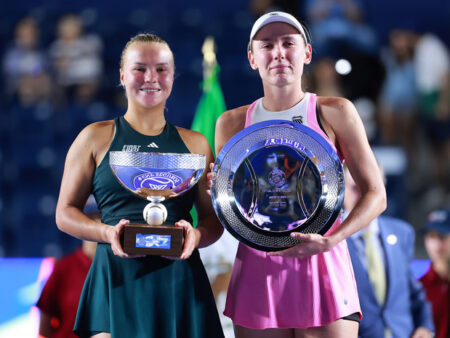Karen Khachanov`s recent departure from the Shanghai Masters singles draw, following a second-round loss, has prompted a familiar question that often lingers in professional tennis: how do the grueling demands of the tour, including participation in doubles, impact a player`s core singles performance?
The world No. 10 Russian, Khachanov, faced a tough challenge against China`s Juncheng Shang, ultimately falling in straight sets (6/7 (3), 3/6). Following the match, the inevitable query arose concerning his participation in the doubles event and whether it played a role in his singles defeat.
The Player`s Perspective: Khachanov`s Candid Assessment
Khachanov, with characteristic frankness, expressed his view that his doubles play was not the primary culprit. “Honestly, I don`t think it`s related,” he stated. However, his subsequent comments painted a broader, more nuanced picture of the challenges faced by players navigating the relentless ATP calendar.
He elaborated on the travel logistics, noting a delayed arrival in Shanghai from Beijing, partly due to his doubles commitments there. This immediate factor sets the stage for a critical element in elite sport: adaptation. For professional athletes, every micro-adjustment counts, from sleep cycles to local cuisine.
Khachanov offered a rationale for his doubles engagement, explaining, “When you arrive at a series of tournaments, whether American or Asian, and you`re out of singles, you still want to stay, get emotions, adrenaline, and continue competing. That`s why we decided a doubles match would be useful.” This highlights a strategic choice: doubles as a means to maintain competitive rhythm and mental engagement, even after a singles setback. It’s a pursuit of continued court time, a form of active recovery for the competitive spirit, albeit one that can, paradoxically, add to the physical load.
Shanghai`s Subtle Snares: Conditions and Adaptation
Beyond the scheduling, Khachanov pointed to the specific environmental conditions in Shanghai as a significant hurdle. “The conditions here are different – you`re sweating buckets. Humidity, heat, compact courts… I would have liked more time to adapt, and perhaps that was partly missing.” This isn`t a complaint, but a technical observation. The subtle variations in court speed, ball bounce, air density, and ambient temperature demand acute physical and technical adjustments that are often invisible to the casual spectator. A top player`s body and game are finely tuned instruments, and any deviation from optimal acclimatization can have profound effects on performance, sometimes leading to outcomes that defy rankings.
The Elusive “Match Dynamics”
Ultimately, Khachanov circled back to what he considered the core issue: “But the main problem is the dynamic of singles matches. When you stop, you can train and prepare more, but then you need to overcome the first match, get into the tournament rhythm, and feel that dynamic again. Perhaps this time, that`s precisely what was missing.”
This insight is crucial. “Match dynamics” encompasses a complex interplay of pressure, timing, decision-making under stress, and the unique physical demands of a best-of-three or best-of-five singles contest. It`s a rhythm that can only be fully acquired and maintained through consistent competitive play. Training sessions, however rigorous, cannot entirely replicate the psychological and physical intensity of a tournament match. The subtle irony, perhaps, is that playing doubles to stay match-fit might inadvertently detract from the very specific rhythm required for peak singles performance, creating a continuous strategic puzzle for players balancing their schedule.
The Broader Picture: A Glimpse into the ATP Grind
Khachanov`s reflections offer a valuable window into the relentless nature of the ATP Tour. It`s a continuous cycle of travel, adaptation, and the constant search for that elusive “match dynamic.” Every early exit is rarely attributable to a single factor; instead, it`s often a confluence of travel fatigue, environmental challenges, strategic choices, and the highly specific requirements of singles tennis.
For elite athletes like Khachanov, maintaining physical prowess is only half the battle. The mental fortitude to constantly recalibrate to new conditions, recover from defeats, and reignite the competitive spark—all while managing a demanding schedule—is arguably the more formidable challenge. His comments serve as a pertinent reminder that behind every scoreline lies a complex narrative of human endeavor against the backdrop of global competition, a narrative far richer than simple wins and losses.










